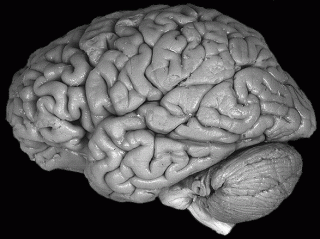Autism
How is the Cerebellum Linked to Autism Spectrum Disorders?
Improving muscle memory helps autistic children socialize and communicate.
Posted September 15, 2013

In a new study looking at toddlers and preschoolers with autism, researchers have found that children with better motor skills were more adept at socializing and communicating. This study adds to growing evidence of the important link between autism and motor skill deficits. Motor skills and muscle memory are held in the cerebellum.
Lead author Megan MacDonald is an assistant professor in the College of Public Health and Human Sciences at Oregon State University. She is an expert on the movement skills of children with autism spectrum disorder (ASD). The findings are published in the September 2013 journal Research in Autism Spectrum Disorders.
Developing motor skills is critical for healthy childhood development. Motor skills help develop better social skills. MacDonald says that previous studies have found 12-year-olds with autism generally perform at around the motor skill level of a 6-year-old. "We know that those children who can sit up, walk, play and run seem to also have better communication skills,” MacDonald said. She adds, "We don't quite understand how this link works, but we know it's there."
For a quick and simple lesson on the cerebrum (up brain) and cerebellum (down brain) and their role in memory and learning please watch this two minute cartoon clip.
Autism and the Cerebellum
My father, Richard M. Bergland, trained to become a neurosurgeon and neuroscientist at New York Hospital-Cornell Medical Center in Manhattan. My dad was the protégé of Bronson Ray who had been a resident under Harvey Cushing, the father of modern neurosurgery. As a surgeon and scientist, my father was always a visionary and a renegade. Being mentored by legends of neuroscience gave my father both the credibility and desire to push new boundaries.
My father grew frustrated by the shortcomings of brain imaging technology and combined his common sense with life experience to come up with new theories about the mind and brain. In the 80s he published a book called The Fabric of Mind (Viking). He also passed on what seemed like revolutionary ideas at the time on to me through conversation. Current research continues to prove that many of my father's hunches that seemed 'out there' decades ago were actually spot on.

Late in his life, my father become obsessed with the cerebellum and the Purkinje cells held in the cerebellum. The mysterious and powerful cerebellum is only 10% of brain volume but holds over 50% of your brain’s total neurons. My father always said, “Whatever the cerebellum is doing, it’s doing a lot of it.”
In May 2013, researchers from the Brain and Mind Research Institute at Weill Cornell Medical College (my dad's Alma Mater) found that defects in the Purkinje cells of the cerebellum are linked to system-wide ASD-like behavioral deficits.
Their findings were published in the journal Nature. Understanding the contribution of cerebellar (of or pertaining to the cerebellum) dysfunction in complex neurological diseases such as autism spectrum disorders (ASD) is an ongoing topic of investigation. The loss of Purkinje cells is a well reported postmortem finding in patients with ASD.
In another study from March 2013, a research team honed in on the gene Tsc2 in Purkinje cells and found that loss of Tsc2 in Purkinje cells lead to autistic-like behavioral deficits. These studies provide compelling evidence that Purkinje cell loss in the cerebellum and/or dysfunction may be an important link between ASD as well as a "general anatomic phenomenon that contributes to the ASD phenotype."
In a third study published April 2013, researchers from the School of Child Development at Osaka University Graduate School of Medicine found that underconnectivity between the cerebellum and other brain regions contributes to the features of ASD.
The good news is that through neurogenesis it is possible to grow new neurons and bulk up the Purkinje cells of the cerebellum. Although MacDonald doesn’t mention the cerebellum in her study, I would make an educated guess that Purkinje cell neurogenesis and neuroplasticity are at the root of improved socialization and communication skills linked to improved motor skills.
In MacDonald's study, children who tested higher for motor skills were also better at "daily living skills," such as talking, playing, walking, and requesting things from their parents. "Even at this early age, we are already seeing motor skills mapping on to their social and communicative skills," MacDonald said. "Motor skills are embedded in everything we do, and for too long they have been studied separately from social and communication skills in children with autism," she added.
Purkinje Cells are Key to Motor Skills and Cognition
Johannes Purkinje first identified what would become known as "Purkinje neurons" in 1837. Dr. Purkinje was also the first person to identify the individuality of the human fingerprint. He had a gift for discovering relatively obvious things that everyone else had overlooked.
The cerebellum has always been an underdog. The cerebellum (Latin: little brain) was named by Leonardo da Vinci in 1504 while he was making wax castings of the brain. When my father died in 2007, I made a vow to him that I would do everything in my power to carry his ideas about the importance of the often underestimated 'little brain' to a mainstream audience. Scientists continue to validate that the cerebrum and cerebellum are equally important and work together.
Although the cerebellum has long been considered a pure motor structure, its involvement in cognitive disorders linked to the loss of Purkinje cells is one of the most consistent neuropathologies found in autistic brains. Cerebellar neuropathologies are also commonly found in schizophrenia. A study from March 2013 suggests possible neuronal mechanisms through which the cerebellum interacts with the prefrontal cortex during many cognitive tasks.
Ideally, all four hemispheres of our brain should work together symmetrically to create a sound mind in a sound body. When things go wrong – such as in autism spectrum disorder or schizophrenia – problems can often be traced to the neural circuitry going haywire at an electrical, chemical, and/or architectural level.
Conclusion: Daily Physicality Bulks Up the Cerebellum at Any Age

People on extended bed rest can lose up to 25% of cerebellar brain volume. Being inactive causes your cerebellum to shrink. On the flip side, being regularly active will bulk up the neurons of your cerebellum. Because the cerebellum is responsible for proprioception and balance when your cerebellum shrinks you are more likely to lose your balance and fall. People of all ages and walks of life should make an effort to keep the cerebellum engaged daily.
Megan MacDonald concludes, "We can teach motor skills and intervene at young ages. Motor skills and autism have been separated for too long. This gives us another avenue to consider for early interventions." MacDonald believes more programs in adaptive physical education should focus on both motor skill development and communicative development.
I have a 6-year-old daughter. Her mom and I have always understood the importance of a broad roster of daily activities that equally flex our daughter's cerebellum and cerebrum. As teachers, parents, coaches, and policy makers it’s important that we all make a concerted effort to create daily routines and enriched environments that engage all four hemispheres of our children's developing brains.
If you'd like to read more about these topics, check out my Psychology Today blog posts:
- "Gesturing Engages All Four Brain Hemispheres"
- "The Neurobiology of the 'Love Hormone' Revealed"
- "These Are Revolutionary Times for the Biology of Psychology"
- "The Neuroscience of Madonna's Enduring Success"
- "Social Connectivity Drives the Engine of Well-Being."
Follow me on Twitter @ckbergland for updates on The Athlete’s Way blog posts.




